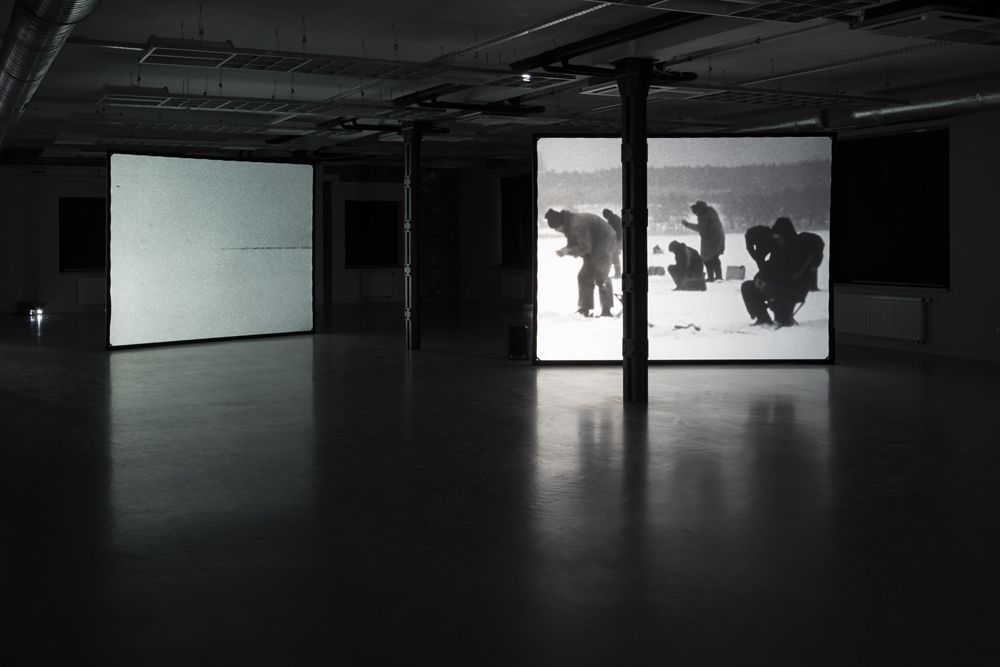
This exhibition is about the sea and its intangible outlines, about the place we inhabit and we don‘t know, about longing, love and the feel of the sea, about meaning slipping through our fingers. Rather than a place for recreation or work, the sea in the exhibited artworks is interpreted as a metaphor of collective imagination and memory. How does life at the sea influence our imagination, speech and feelings? How is it conveyed in them? By means of creative reflections artists are drawing the horizon in the mental landscape of the sea – a hypothetical territory that connects the shores of imagination, reality, past and present.
Irma’s contemporary icons and found anonymous love letter (to the sea?) combines real and virtual spaces, collects those who go fishing for feelings, humans and fish. Laura Stasiulytė contrasts ice fishing rituals with scientific research of the bottom of the Baltic Sea, and exposes a gap between things we wish to believe in and things we are forced to acknowledge. The line Arnas is drawing takes you around the Sea, but does not bring to the starting point. Instead, it takes off and ends up in some parallel space. An endless journey backwards by Irma and Jurgita plaits the interior of a building into a long rope, tears it off the ground and sets out into the open sea. A mechanical wave by Laura Zala quenches longing and attempts to reconstruct the sea out of a sound cell. Meanwhile Egle’s preservation of the memory of residents of Klaipėda alludes to skimming the surface as well as to the mist which often lingers behind symbols.
Artworks installed in different locations of the Culture Factory invite you for a journey: “Waves” by Laura Zala and “Ambassadors” by Arnas have settled in the basement of the Factory, “The Catch” by Irma is in the conference hall on the ground floor, “Bottom” by Laura Stasiulytė and “Meridianas” by Eglė are on the 4th floor, and “Ship” by Irma and Jurgita has risen to the 5th floor. An exhibition guide will help you to find your way.
Artists: Arnas Anskaitis, Jurgita Remeikytė, Irma Stanaitytė, Laura Stasiulytė, Eglė Vagnoriūtė, Laura Zala
The exhibition was initiated by participating artists and coordinated by Rasa Antanavičiūtė (Nida Art Colony of Vilnius Academy of Arts)
Visiting hours: 11 AM to 5 PM and during the evening events on workdays, 4 PM to 8 PM on weekends
The exhibition will be open until 6 December 2014.
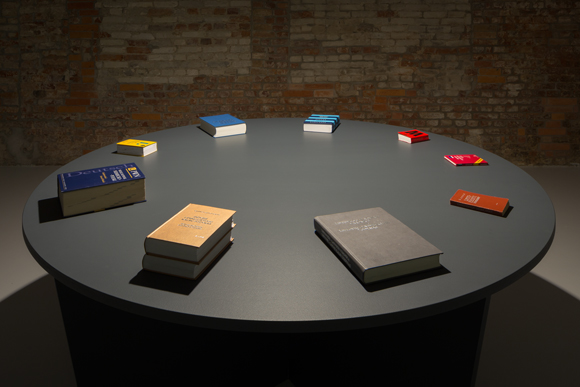
Arnas Anskaitis, The Ambassadors, 2014, 9 most recent and most comprehensive bilingual dictionaries from the Baltic region states arranged in a circle according to the cardinal directions on a round table
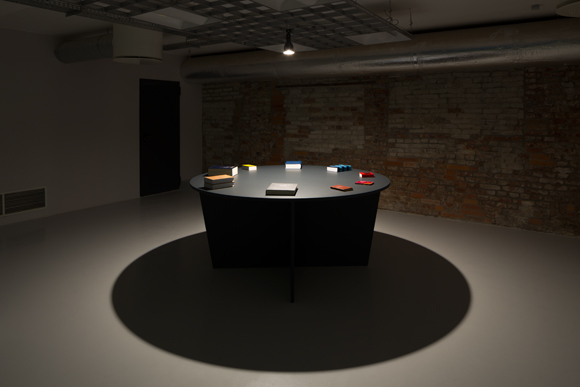
Arnas Anskaitis, The Ambassadors, 2014, 9 most recent and most comprehensive bilingual dictionaries from the Baltic region states arranged in a circle according to the cardinal directions on a round table
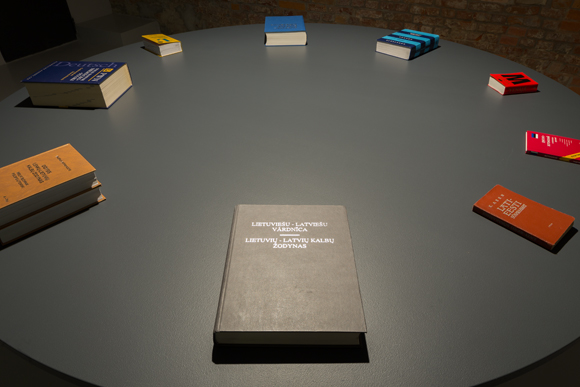
Arnas Anskaitis, The Ambassadors, 2014, 9 most recent and most comprehensive bilingual dictionaries from the Baltic region states arranged in a circle according to the cardinal directions on a round table
The Baltic Sea connects as well as separates nine countries that border the sea: Denmark, Estonia, Finland, Germany, Latvia, Lithuania, Poland, Russia, and Sweden. What if we combine the linguistic map with the geopolitical one? For example, if one wants to translate, say, an unfamiliar German word to Lithuanian, one has to look for a German-Lithuanian dictionary. However, Germany and Lithuania do not have a common border, they are not neighbours. Poland is located between the two countries. Then we would first need to translate a particular word from Lithuanian to Polish, and then from Polish to German. However, in the process, not every word or phrase would reach its “destination” and some extra words or phrases would inevitably emerge. This way we could observe (in our mind’s eye) how words start travelling (literally) across territories.
Bilingual dictionaries are lists of correspondence that seek to relate two languages in order to define equivalence between the meanings of individual words. Thus, they serve as social institutions, as peculiar customs offices, which are responsible for controlling the flow of legitimate words and phrases in and out of the country.
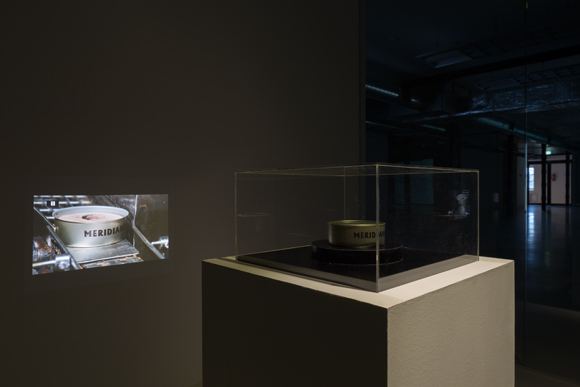
Eglė Vagnoriūtė, Meridianas, 2013, object, video
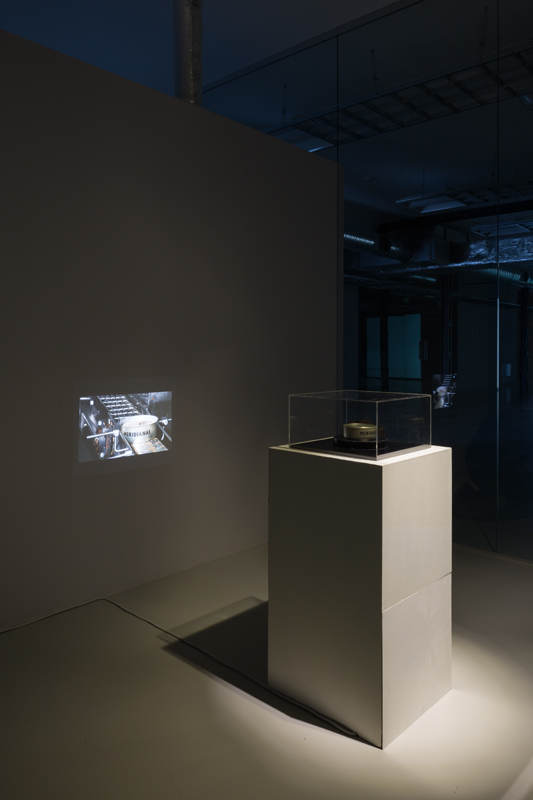
Eglė Vagnoriūtė, Meridianas, 2013, object, video
“Meridianas” is a vessel that became a symbol of the city of Klaipėda in the recent decades.
In its broadest sense, a symbol has to bare a conventionally understood meaning of an abstract concept or idea. Majority of Klaipėda residents agree that the ship is the symbol of their city, yet many are unable to explain why?
The sailboat was built in 1948 in a Finnish shipyard in Turku. “Meridianas” is not the only one of its kind – there were more than forty similar vessels produced employing modern technologies of glued wood. She was not built as a symbol. Her primary purpose was to become part of the Finnish contribution to the Soviet Union; Soviet officers directed it to Klaipėda – one of the Soviet ports then. Until 1968 “Meridianas” was sailed by cadets from Klaipėda Maritime School during their exercises in the sea. After an accident in 1968, during which six cadets perished, the ship became defunct and in 1969 she was anchored to a bank of the river Danė in the centre of the city. During the next two years the sailboat went under reconstruction and was adapted to the new – commercial – purposes: it was turned into a restaurant. For more than three decades its location did not change. This most probably determined the transformation of the ship into a symbol. The wooden ship was constantly demanding maintenance and instigated controversial debates on the necessity to preserve it. “Meridianas” went under several stages of renovation. During the most recent one most of the wood was replaced by a completely new material – metal. Although the story of the ship‘s arrival to Klaipėda related to the occupational regime, it was overwhelmed by a public desire to see the beautiful and the new, but at the same time somewhat familiar sight in the city centre.
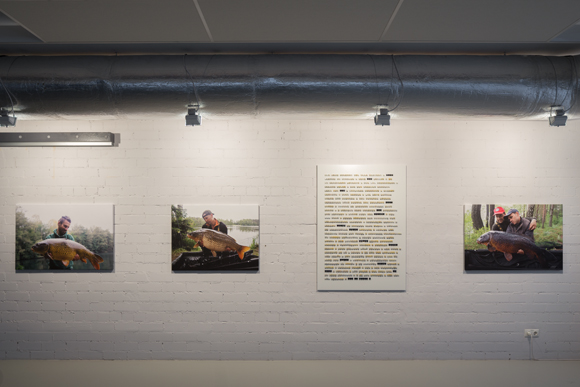
Irma Stanaitytė, The Catch, 2014, text, photographs
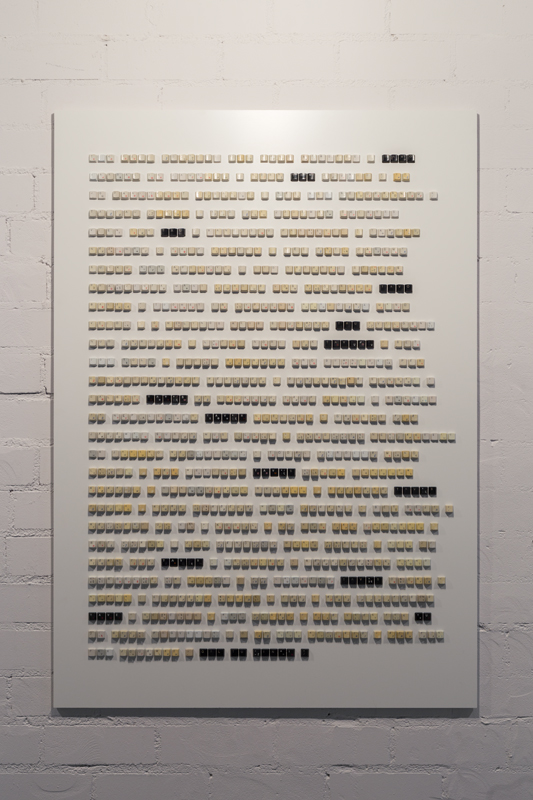
Irma Stanaitytė, The Catch, 2014, text, photographs
An internet love letter made of used keyboard keys. This text is creation with no traceable authorship, a kind of contemporary “Song of Songs”. It wonders through dating websites, blogs, sites, advising on love and life. It is appropriated, adored and adapted to individual needs again and again.
Photographs on canvases show images from websites dedicated to fishing, that share pictures of the biggest catch of the day, of the month, of the year or of the entire life. Most of the pictures featuring fishermen with their catch have very similar iconography of composition and share the same strange, almost mystic mood, which makes them resemble sacral art and its motives.
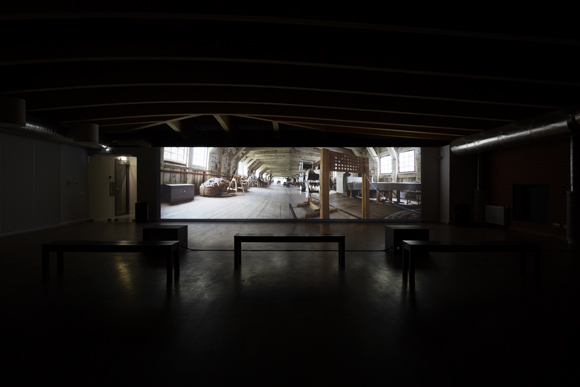
Irma Stanaitytė ir Jurgita Remeikytė, Ship, 2012, 2 HD video, 25 min. (loop)
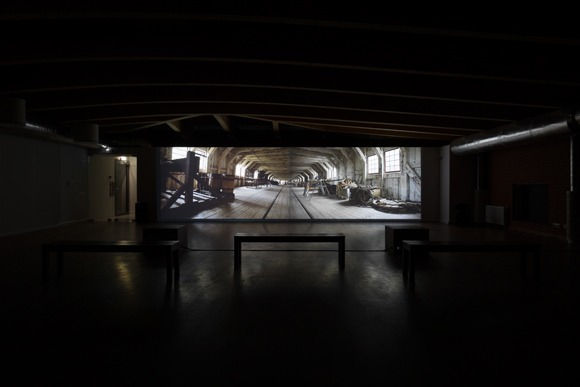
Irma Stanaitytė ir Jurgita Remeikytė, Ship, 2012, 2 HD video, 25 min. (loop)
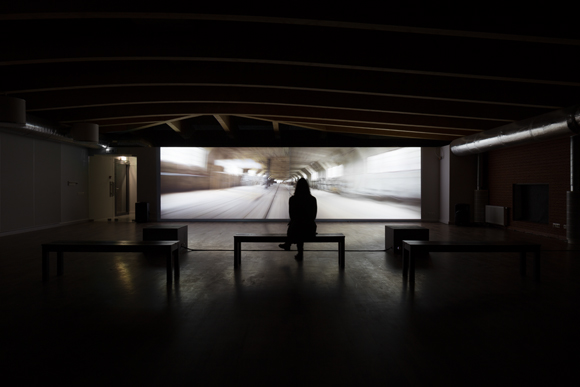
Irma Stanaitytė ir Jurgita Remeikytė, Ship, 2012, 2 HD video, 25 min. (loop)
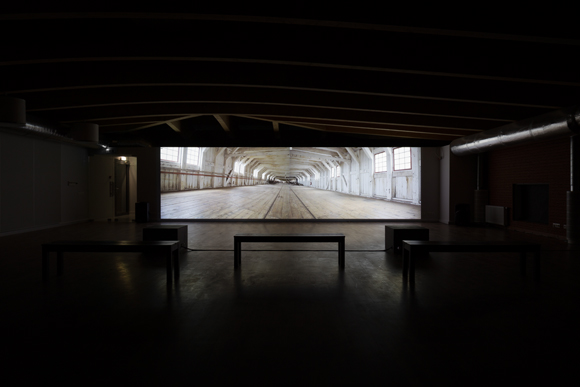
Irma Stanaitytė ir Jurgita Remeikytė, Ship, 2012, 2 HD video, 25 min. (loop)
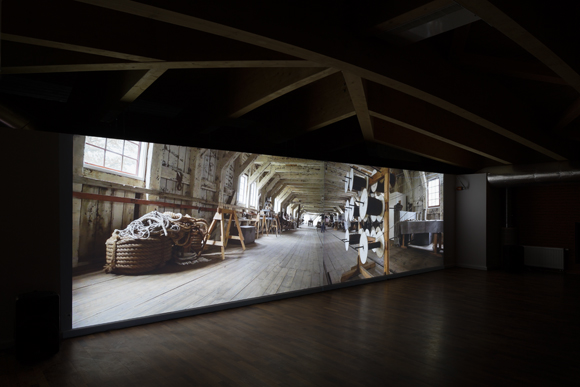
Irma Stanaitytė ir Jurgita Remeikytė, Ship, 2012, 2 HD video, 25 min. (loop)
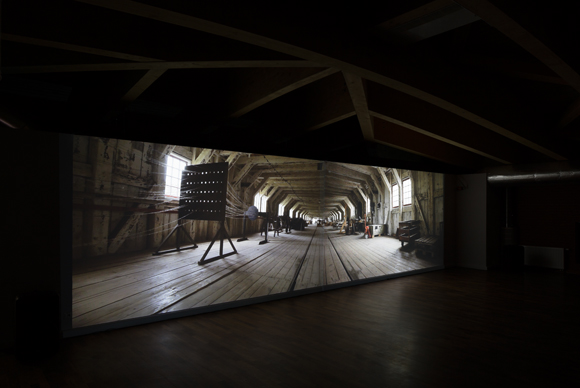
Irma Stanaitytė ir Jurgita Remeikytė, Ship, 2012, 2 HD video, 25 min. (loop)
The work was inspired by a visit to the Ropewalk (Repslagarbanan) in Karlskrona – the longest wooden building in Sweden constructed in 1692-1693. It was constructed 300 meters long in order to manufacture ropes of such length. In the age of new technologies such an organic conformity of physical space and its function is very rare. This fact stimulated to create a corresponding metaphorical link – by filming the space in a certain way, i.e. employing specific techniques, we transformed the space itself into an object.
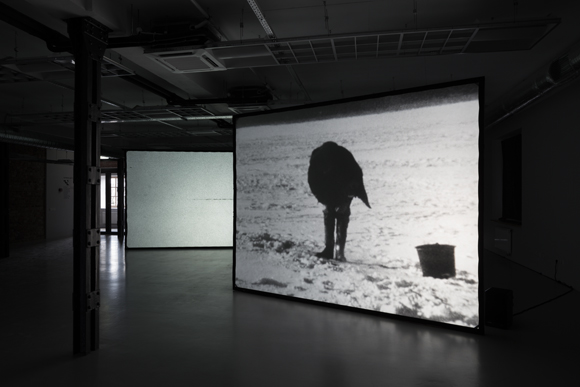
Laura Stasiulytė, Bottom (part I), 2014, 2 channel video installation, 2×4:3, digitised 8 mm b/w film, sound, 21 min and 3min, loops
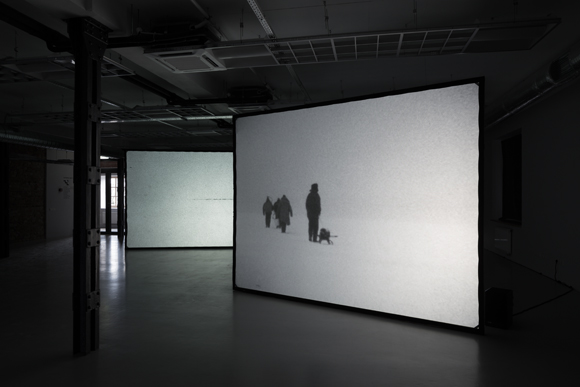
Laura Stasiulytė, Bottom (part I), 2014, 2 channel video installation, 2×4:3, digitised 8 mm b/w film, sound, 21 min and 3min, loops
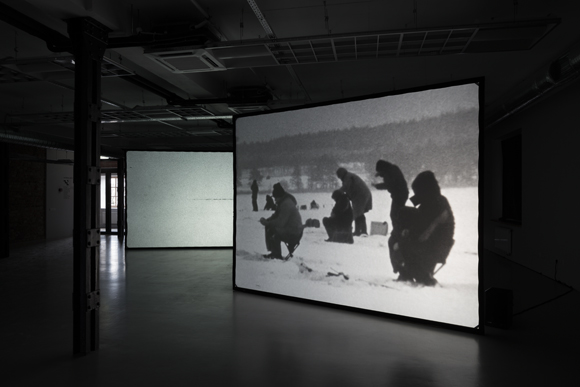
Laura Stasiulytė, Bottom (part I), 2014, 2 channel video installation, 2×4:3, digitised 8 mm b/w film, sound, 21 min and 3min, loops
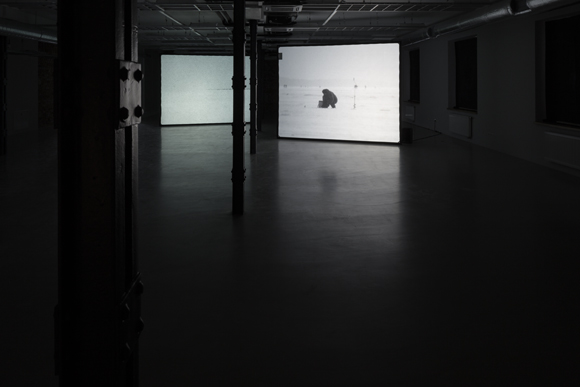
Laura Stasiulytė, Bottom (part I), 2014, 2 channel video installation, 2×4:3, digitised 8 mm b/w film, sound, 21 min and 3min, loops
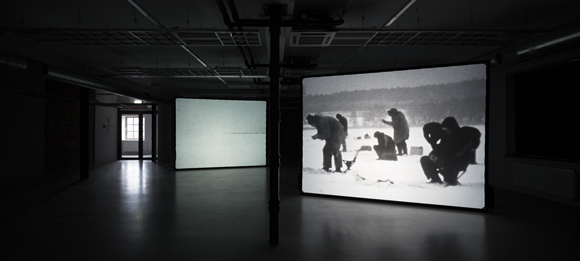
Laura Stasiulytė, Bottom (part I), 2014, 2 channel video installation, 2×4:3, digitised 8 mm b/w film, sound, 21 min and 3min, loops
The artist is interested in places and situations which are between leisure and danger, between pleasure and tragedy, between imaginary and real worlds.
She looks into sediments of different historical heritage, which meet at the bottom of the Sea: local extinct acoustic fishing method and trophy chemical weapon, which was scattered at the Baltic Sea after the Second World War.
The artist talks about fishermen and smelts which constantly diminish in number and smell like cucumbers, about yperite, which is found in fishing nets, looks very much like amber and smells like mustard.
Almost every year, when the Curonian Lagoon freezes, Laura Stasiulytė gets on the ice with an 8 mm camera and a 9 m long hydrophone, used earlier to detect submarines. The 8 mm black and white film erases links to today’s time and place, and turns “here” into “somewhere” and “now” into “once”.
She has met the researchers from Marine Research Department of the Environmental Protection Agency in Klaipėda and plans to join their regular expeditions testing Baltic Sea water, to get closer to the liminal points on the map and to realise the second part of her creative project.
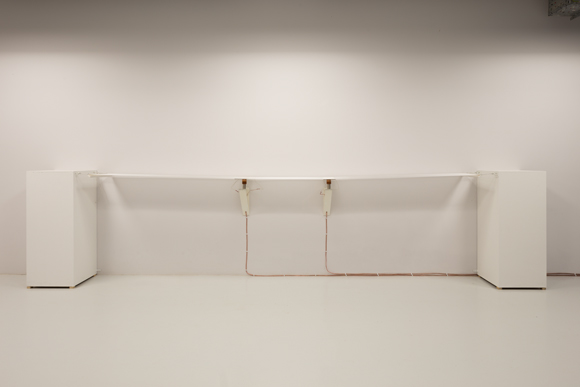
Laura Zala, Waves, 2012, object, sound
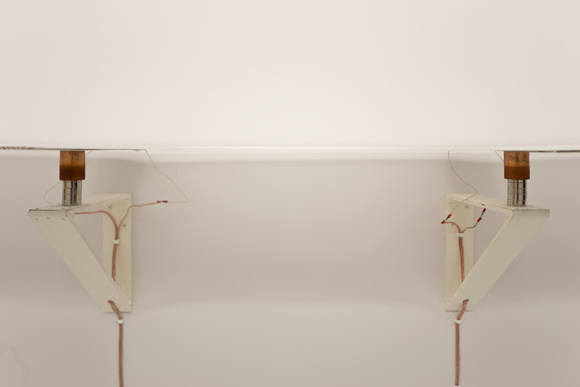
Laura Zala, Waves, 2012, object, sound
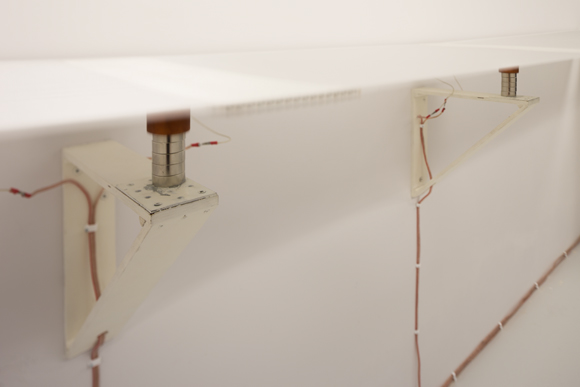
Laura Zala, Waves, 2012, object, sound
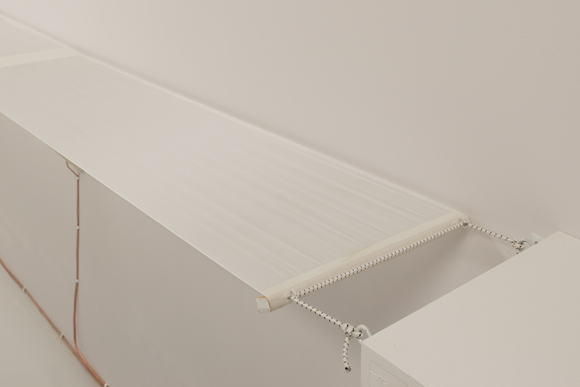
Laura Zala, Waves, 2012, object, sound
In this installation sound – a wave in physics – represents the Baltic Sea. Some researchers derive its name from the Lithuanian word baltas (white), others – from the Germanic word belt (band). Thus a white silk band is used in the installation. Coils – parts of loudspeakers – are fastened beneath the band and connected to magnets. A record of the sea sough generates alternating current, which triggers the coils. Moving in and out of the magnetic field makes the sea move.
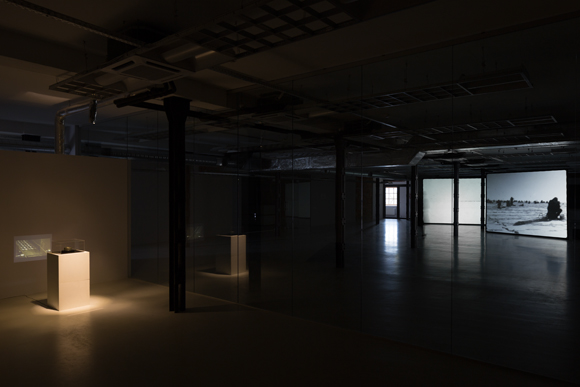
Photographs by Arnas Anskaitis






























